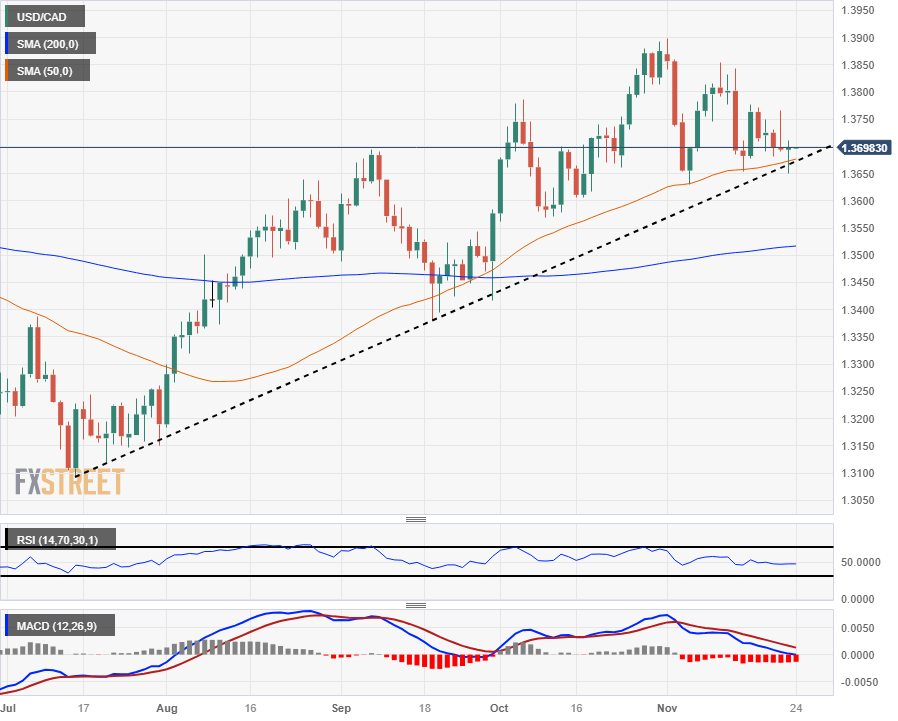- The Canadian Dollar caught a breather as the Loonie market goes flat.
- Friday’s Canada Retail Sales to be overshadowed by US PMIs.
- Thursday set to be a quiet session with the US out for Thanksgiving.
The Canadian Dollar (CAD) held steady on Thursday, with the USD/CAD trading closely with the day’s opening bids. Friday will see US equity markets return to the fold for a reduced trading day before shutting down again for the weekend.
Friday will also see the latest round of Retail Sales from Canada, but the release is likely to be overshadowed by the US Purchasing Managers’ Index (PMI) release.
Daily Digest Market Movers: Canadian Dollar flatlines, capped by soft Crude Oil bids
- The CAD ground into the middle as US holiday trading volumes deflated market momentum.
- The Loonie initially kicked higher on the day but quickly fell back to Thursday’s opening bids.
- Crude Oil is seeing some downside play, limiting CAD support.
- In a speech on Wednesday, Bank of Canada (BoC) Governor Tiff Macklem highlighted that BoC policymakers “might” have done enough to tame inflation, balance economy.
- Friday’s CAD Retail Sales to have limited impact as traders focus on US PMIs.
- Median market forecasts are expecting flat results or slight declines in both data sets.
- CAD Retail Sales in September expected to print 0.0%, previous -0.1%.
- Retail Sales Excluding Vehicles is expected to reveal a -0.2% decline in consumption spending.
- US November PMIs are forecast to decline in both the Services and Manufacturing components.
- Services are forecast to tick lower from 50.6 to 50.4, while Manufacturing is expected to fall into contractionary territory at 49.8 versus October’s 50.0.
Canadian Dollar price this week
The table below shows the percentage change of Canadian Dollar (CAD) against listed major currencies this week. Canadian Dollar was the strongest against the US Dollar.
| USD | EUR | GBP | CAD | AUD | JPY | NZD | CHF | |
| USD | 0.00% | -0.65% | -0.16% | -0.70% | -0.26% | -0.83% | -0.19% | |
| EUR | -0.01% | -0.67% | -0.17% | -0.71% | -0.27% | -0.84% | -0.20% | |
| GBP | 0.64% | 0.67% | 0.49% | -0.08% | 0.40% | -0.17% | 0.47% | |
| CAD | 0.16% | 0.15% | -0.50% | -0.55% | -0.10% | -0.67% | -0.03% | |
| AUD | 0.69% | 0.70% | 0.06% | 0.55% | 0.44% | -0.12% | 0.51% | |
| JPY | 0.26% | 0.27% | -0.63% | 0.11% | -0.44% | -0.57% | 0.07% | |
| NZD | 0.83% | 0.84% | 0.18% | 0.67% | 0.12% | 0.57% | 0.64% | |
| CHF | 0.19% | 0.20% | -0.46% | 0.03% | -0.52% | -0.07% | -0.64% |
The heat map shows percentage changes of major currencies against each other. The base currency is picked from the left column, while the quote currency is picked from the top row. For example, if you pick the Euro from the left column and move along the horizontal line to the Japanese Yen, the percentage change displayed in the box will represent EUR (base)/JPY (quote).
Technical Analysis: Canadian Dollar holds steady, USD/CAD goes flat near 1.3700
The Canadian Dollar (CAD) is losing all momentum on Thursday, trading closely with the day’s opening bids of 1.3700 against the US Dollar (USD). The USD/CAD briefly fell into a new low for the week as the Loonie found some bidding (or the Greenback just lost some steam), but a slight softening in Crude Oil bids is pulling the CAD back into the day’s starting gate.
The USD/CAD briefly dipped into 1.3650 before getting pushed back into near-term median bids at the 50-hour Simple Moving Average (SMA). Intraday action continues to see constraint from the 200-hour SMA declining into 1.3720.
On the daily candlesticks, Thursday’s bounce back into 1.3700 makes more sense following a rebound from the 50-day SMA, and technicals are lining up for a slow grind with technical support from the 50 and 200-day SMAs at 1.3670 and 1.3512, respectively.
Technical indicators are leaning into the midrange as momentum leaks out of the USD/CAD chart in the medium term. The Relative Strength Index (RSI) is drifting around the 50.0 middle level, while the Moving Average Convergence Divergence (MACD) has multiple levels of moving averages constraining it into the zero threshold, indicating an overall lack of strength in either direction.
USD/CAD Hourly Chart

USD/CAD Daily Chart

Canadian Dollar FAQs
What key factors drive the Canadian Dollar?
The key factors driving the Canadian Dollar (CAD) are the level of interest rates set by the Bank of Canada (BoC), the price of Oil, Canada’s largest export, the health of its economy, inflation and the Trade Balance, which is the difference between the value of Canada’s exports versus its imports. Other factors include market sentiment – whether investors are taking on more risky assets (risk-on) or seeking safe-havens (risk-off) – with risk-on being CAD-positive. As its largest trading partner, the health of the US economy is also a key factor influencing the Canadian Dollar.
How do the decisions of the Bank of Canada impact the Canadian Dollar?
The Bank of Canada (BoC) has a significant influence on the Canadian Dollar by setting the level of interest rates that banks can lend to one another. This influences the level of interest rates for everyone. The main goal of the BoC is to maintain inflation at 1-3% by adjusting interest rates up or down. Relatively higher interest rates tend to be positive for the CAD. The Bank of Canada can also use quantitative easing and tightening to influence credit conditions, with the former CAD-negative and the latter CAD-positive.
How does the price of Oil impact the Canadian Dollar?
The price of Oil is a key factor impacting the value of the Canadian Dollar. Petroleum is Canada’s biggest export, so Oil price tends to have an immediate impact on the CAD value. Generally, if Oil price rises CAD also goes up, as aggregate demand for the currency increases. The opposite is the case if the price of Oil falls. Higher Oil prices also tend to result in a greater likelihood of a positive Trade Balance, which is also supportive of the CAD.
How does inflation data impact the value of the Canadian Dollar?
While inflation had always traditionally been thought of as a negative factor for a currency since it lowers the value of money, the opposite has actually been the case in modern times with the relaxation of cross-border capital controls. Higher inflation tends to lead central banks to put up interest rates which attracts more capital inflows from global investors seeking a lucrative place to keep their money. This increases demand for the local currency, which in Canada’s case is the Canadian Dollar.
How does economic data influence the value of the Canadian Dollar?
Macroeconomic data releases gauge the health of the economy and can have an impact on the Canadian Dollar. Indicators such as GDP, Manufacturing and Services PMIs, employment, and consumer sentiment surveys can all influence the direction of the CAD. A strong economy is good for the Canadian Dollar. Not only does it attract more foreign investment but it may encourage the Bank of Canada to put up interest rates, leading to a stronger currency. If economic data is weak, however, the CAD is likely to fall.
Information on these pages contains forward-looking statements that involve risks and uncertainties. Markets and instruments profiled on this page are for informational purposes only and should not in any way come across as a recommendation to buy or sell in these assets. You should do your own thorough research before making any investment decisions. FXStreet does not in any way guarantee that this information is free from mistakes, errors, or material misstatements. It also does not guarantee that this information is of a timely nature. Investing in Open Markets involves a great deal of risk, including the loss of all or a portion of your investment, as well as emotional distress. All risks, losses and costs associated with investing, including total loss of principal, are your responsibility. The views and opinions expressed in this article are those of the authors and do not necessarily reflect the official policy or position of FXStreet nor its advertisers. The author will not be held responsible for information that is found at the end of links posted on this page.
If not otherwise explicitly mentioned in the body of the article, at the time of writing, the author has no position in any stock mentioned in this article and no business relationship with any company mentioned. The author has not received compensation for writing this article, other than from FXStreet.
FXStreet and the author do not provide personalized recommendations. The author makes no representations as to the accuracy, completeness, or suitability of this information. FXStreet and the author will not be liable for any errors, omissions or any losses, injuries or damages arising from this information and its display or use. Errors and omissions excepted.
The author and FXStreet are not registered investment advisors and nothing in this article is intended to be investment advice.
Recommended content
Editors’ Picks

EUR/USD holds steady ahead of this week’s tariff showdown
EUR/USD flubbed a bullish run at the 1.0850 level on Monday, kicking off the new trading week on decidedly tepid footing. Investors are preparing for the newest round of tariff threats from US President Donald Trump.

AUD/USD regains traction toward 0.6300 after RBA Governor Bullock's presser
AUD/USD is marching back toward 0.6300 in Tuesday's Asian trading, capitalizing on RBA Governor Bullock's prudence amid global uncertainties. The Australian central bank warranted caution on the inflation outlook while maintaining the key rate at 4.1% earlier in the session.

Gold price extends bullish trend amid rising trade tensions; fresh record high and counting
Gold price continues to scale new record highs for the fourth straight day on Tuesday. Worries about the widening global trade war and geopolitical risks boost the commodity. Fed rate cut bets weigh on the USD and further benefit the non-yielding yellow metal.

PEPE could rally to double digits if it breaks above its key resistance level
Pepe memecoin approaches its descending trendline, trading around $0.000007 on Tuesday; a breakout indicates a bullish move ahead. Moreover, PEPE's long-to-short ratio supports a bullish thesis as bullish bets among the traders reach the highest over a month.

US: Trump's 'Liberation day' – What to expect?
Trump has so far enacted tariff changes that have lifted the trade-weighted average tariff rate on all US imports by around 5.5-6.0%-points. While re-rerouting of trade will decrease the effectiveness of tariffs over time, the current level is already close to the highest since the second world war.

The Best brokers to trade EUR/USD
SPONSORED Discover the top brokers for trading EUR/USD in 2025. Our list features brokers with competitive spreads, fast execution, and powerful platforms. Whether you're a beginner or an expert, find the right partner to navigate the dynamic Forex market.

